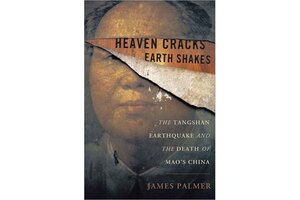Heaven Cracks, Earth Shakes
British travel writer James Palmer offers a quick, highly readable account of a pivotal moment in China’s recent past.

Heaven Cracks, Earth Shakes:
The Tangshan Earthquake and the Death of Mao’s China
By James Palmer
Basic Books
320 pp.
Question: What does it mean when dogs bite their owners, chickens attempt to fly, and cats wake their owners? According to Chinese folklore, such omens may presage the arrival of an earthquake – or the passing of an emperor.
In 1976, both things happened almost simultaneously in China. Very early on the morning of July 28, 1976, a magnitude 7.8 earthquake nearly obliterated the mining city of Tangshan, in northeastern China, while most of its people slept. The earthquake – which killed hundreds of thousands of Chinese – was the deadliest of the 20th century.
Less than two months later, on Sept. 9, Chinese chairman Mao Zedong died after a long illness, leaving the future of his country – and the revolution he fomented – anything but certain.
Malcolm Gladwell might have called it a tipping point. But British historian and author James Palmer ("The Bloody White Baron") refers instead to a Chinese proverb: “The heavens crack, and the earth shakes.” In 1976, points out Palmer, “Maoist rule in China cracked ... [and] the second part of the saying came true in all too literal – and lethal – a fashion.”
For Palmer, the China we know today was forged in the crucible of 1976 and it is the story of that fateful 12-month span that he tells in his helpful new book Heaven Cracks, Earth Shakes.
Mao lingered, close to death for most of the year. Earlier that year, the Chinese had already been badly shaken by the death of their beloved prime minister Zhou Enlai. When Mao finally succumbed, he left behind successors only too eager to wrestle for control of China’s soul.
By 1976, the Chinese were a weary people. After the violent chaos of the Cultural Revolution and the horrific mass starvation of the Great Leap Forward, the “glamour of the revolution had rubbed off,” Palmer writes.
The China Palmer describes has eerie echoes of North Korea: a scary realm where entertainment – in any form – was nearly non-existent and the memory of hunger was never far away.
Palmer gives texture to his story by sprinkling his account with glimpses of ordinary Chinese and their lives: a young factory worker and her roommates pool their funds to buy a goldfish to warn against earthquakes; a printing plant worker takes a lesson in tai chi at three in morning, which means he's in a city park at the exact moment that the quake hits; after the disaster a surviving family forgets the political persecution they have faced and generously feeds their enemies.
But even as these frightened survivors struggle to hold their lives together, behind the scenes, in the Chinese government, tectonic plates are shifting, grinding, and colliding, We may take it for granted today that Deng Xiaoping and his pragmatic ways prevailed, but in 1976 the triumph of moderation was anything but certain.
Palmer finishes his book with a visit to the Tangshan memorial wall, finally built in 2010. There, the Chinese crowds surge past the government propaganda inscribed on the walls, ignoring it in favor of exiting toward the sunshine.
For Palmer, it seems, that’s more or less what happened in 1976 as well. His quick, highly readable account of a pivotal moment in China’s recent past makes good reading for all hoping to better understand the global giant’s present and future.
Marjorie Kehe is the Monitor’s Books editor.

